- This page contains pictures and information about Braconid Wasps that we
found in the Brisbane area, Queensland, Australia.
-
 - One way to distinguish them from Ichneumon Wasps is that the Braconid Wasps
2nd recurrent vein of the fore wing is absent.
-
- Members in this Braconidae family have long and thin body, long antenna and some with
very long ovipositor. They have narrow waist like
most other wasps. They are from small to medium in size, usually smaller
than those in Ichneumonidae.
-
- Braconid Wasp larvae are parasitic and most caterpillars are targeted host. The female wasp usually locates the food plants of the host
then searches with her antennae for the host. The female has the long ovipositor which is used to insert eggs into the host's body. The host will
usually survive when the larvae is still living inside. Until the larvae fully grown,
the wasp larvae either pupates inside the dead host or form a cocoon outside.
-
- The two families Braconidae and Ichneumonidae
are very close related and some species look similar. They can be distinguished
by the forewing venation. In the Ichneumons there is an extra vein creating
a cell which can not be found on Braconids.
-
- Many aphid parasites are Braconid and their life cycles are similar.
-
-
- Subfamily Doryctinae
- Most Wasps in
subfamily Doryctinae are ectoparasitic on larvae of wood-boring and
bark-mining Coleoptera. Some are parasitic on moth or sawfly larvae. There
are the reduced wing species in this subfamily.

 -
- Subfamily Braconinae - Orange Braconid Wasps
- Braconid wasp in this subfamily are often black, red, orange and white in
colours. Their wings are often dark or yellow-banded. They are from small to
medium size. Females have the extended ovipositor. Their larvae are mostly external parasitic on
moth caterpillars but several species are also known to parasitise concealed
beetle, fly
and sawfly larvae.
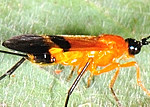 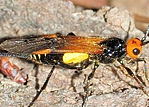
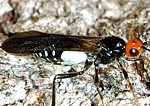

 
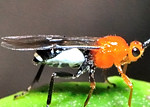 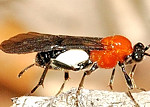
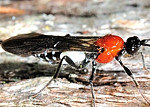 -
- Subfamily Opiinae
- Wasps in this Subfamily Opiinae are small in size, often orange or yellow
in colours. Most of them are parasitic on larvae of fruit flies.
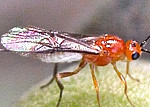
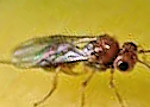 -
- Subfamily Aphidinae (Aphidiinae)
- Wasps in this Subfamily are very small, about 1mm in body length. The
larvae are internal parasites of aphids, pupate inside the host.
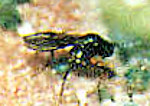 -
- Subfamily Helconinae
- Braconid Wasps in subfamily Helconinae are endoparasites of Coleoptera larvae.
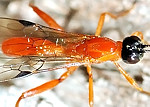
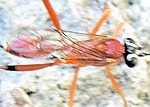
- Subfamily Agathidinae (Agathidiinae)
- Braconid Wasps in this subfamily are from small to medium size. They are
usually orange in colour with black and orange wings. Larvae are internal
parasites of
moth caterpillars.
-
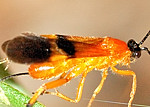
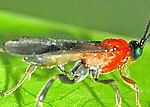 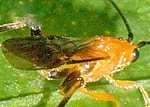
-
- Subfamily Microgastrinae
- Braconid Wasps in
subfamily Microgastrinae are dark brown to black in colours. They are small
in size. They are the parasitoids of moth
caterpillars.
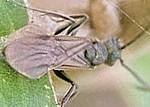 -
- Unknown Braconid
- Please send us email
if you can identify the following unknown Braconid Wasps.
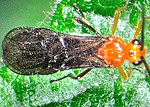
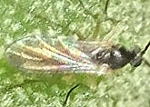 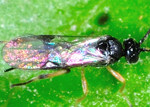
- Reference:
- 1. Insects
of Australia, CSIRO, Division of Entomology, Melbourne University
Press, 2nd Edition 1991, p945.
- 2. Northern
Territory Insects, A Comprehensive Guide CD - Graham Brown, 2009,
- 3. Wasps - family Braconidae
- lifeunseen.com, by Nick Monaghan.
- 4. Family BRACONIDAE - Australian Faunal Directory, Australian Biological Resources Study.
- 5. What
wasp is that? - An interactive identification guide to the
Australasian families of Hymenoptera, 2007.
- 6. Insects of Australia and New Zealand - R. J. Tillyard, Angus
& Robertson, Ltd, Sydney, 1926, p269.
- 7. Braconine wasps of Australia - Quicke, D.L.J., Ingram, S.M. (1993), Memoirs of the Queensland Museum 33 (1): 299-336.
- 8. Illustrated key to the subfamilies of the Braconidae (Hymenoptera: Ichneumonoidea) - C. van Achterberg, 1993, Zoologische Verhandelingen Vol. 283 p. 1-189.
- 9. Braconine wasps of Australia - Quicke,
D.L.J., Ingram, S.M. (1993), Memoirs of the Queensland Museum 33 (1): 299-336.
[ Home ] [ Doryctinae ] [ Braconinae ] [ Opiinae ] [ Aphidinae ] [ Helconinae ] [ Agathidinae ] [ Microgastrinae ] [ Unknown Braconid Wasps ]
|